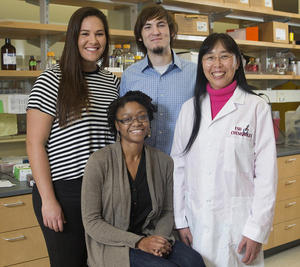Researchers work to decipher genetic data in hunt for new prostate cancer treatments
Researchers in Florida State University's Department of Chemistry and Biochemistry are working on new approaches to deciphering genetic data that may lead to new, more targeted prostate cancer treatments.

Clockwise from left: Undergraduate researchers Ariana K. von Lersner and Charles J. Robbins; Qing-Xiang "Amy" Sang, professor of chemistry and biochemistry and the Endowed Professor of Cancer Research at Florida State; and graduate student Jennifer S. Myers.
Prostate cancer, which affects one in seven men in the United States, tends to have multiple tumor sites within an individual prostate and each might be genetically different. Tumor characteristics also differ among racial and ethnic groups.
“With the availability of patient genomic data, we can look deep inside a tumor to consider its genetic background and find more effective prostate cancer treatments,” said graduate student Jennifer S. Myers.
Patient genomic data has spurred an increased drive toward personalized medicine or therapies tailored to the patient’s tumor characteristics. However, the relative ease of genomic sequencing and the push for patient-specific treatment has created a different challenge: How can scientists best sift through data of more than 20,000 genes to pinpoint genetic changes that matter in cancer development, progression or treatment?
Myers and undergraduate researchers Ariana K. von Lersner and Charles J. Robbins identified genetic changes in prostate cancer by looking at altered signal pathways instead of focusing on individual genes. They were led by Qing-Xiang Amy Sang, professor of chemistry and biochemistry and the Endowed Professor of Cancer Research at Florida State.
Their findings, “Differentially Expressed Genes and Signature Pathways of Human Prostate Cancer,” were published in the journal PLOS One.
“Imagine trying to find a single altered gene among a haystack of more than 20,000 genes,” Myers said. “Now imagine doing this for the hundreds of thousands of men diagnosed with prostate cancer each year. The task is daunting.”
Because genes work in concerted networks to exert their molecular effects, changes in gene expression should be indicative of altered pathways.
“By looking for altered pathways, we’ve significantly increased the size of our target,” she said.
Although genetic profiles vary from patient to patient, the authors hypothesized that genetic changes should converge at the pathway level.
Two findings in their work stood out — the alteration of the transforming growth factor-beta (TGF-β) signaling pathway in prostate cancer and the regulation by Ran, a type of protein, of the mitotic spindle formation pathway in prostate cancer.
While the TGF-β pathway has been extensively studied in prostate cancer, the Ran/mitotic spindle pathway and the role of Ran overexpression in prostate cancer is not yet clear.
“The fact that we identified a well-studied pathway in prostate cancer gives us confidence in our method,” Myers said. “Our next steps will be to confirm the significance of the Ran/mitotic spindle pathway in prostate cancer.”

